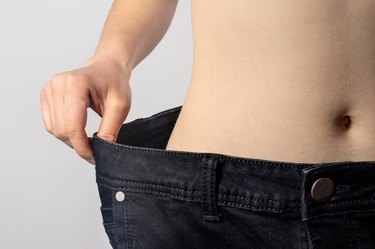
When it comes to belly fat and health, your shape matters. According to Harvard Health Publishing, if extra weight gives you a pear shape, you have what's called subcutaneous fat. But if you have a beer gut that gives you an apple shape, you have visceral fat, which is more dangerous to your health.
"The reason subcutaneous fat makes you look like a pear is that it settles in your hips and bottom," says Mary Vouyiouklis Kellis, MD, an endocrinology specialist in the Department of Diabetes and Metabolism at the Cleveland Clinic. "Visceral fat sits inside your belly and is strongly linked to health problems. It increases your risk for diabetes and makes diabetes harder to treat."
Video of the Day
Video of the Day
Read more: The 3 Secrets to Losing Belly Fat
Visceral Fat and Diabetes
Harvard Health explains that visceral fat — which becomes more common during middle age — is the type of fat that gives you a big, firm belly. Unlike subcutaneous fat, you can't grab it with your hand. That's because visceral fat is located inside your belly, in the spaces between your abdominal organs.
Too much fat around your waist also increases health risks more than having fat elsewhere in your body, according to the National Institute of Diabetes and Digestive and Kidney Diseases (NIDDK). A waist size of more than 35 inches for women and more than 40 inches for men is considered too much belly fat.
Excess belly fat is one of four major risk factors for diabetes (along with a family history of diabetes, a poor diet and lack of physical activity), and nearly 90 percent of people with diabetes are overweight, says NIDDK.
"Visceral fat is bioactive," Dr. Kellis says. "It gives off chemicals called cytokines that increase your resistance to insulin. Your body needs insulin to move sugar into your cells. Insulin resistance increases your blood sugar, which increases your risk of diabetes." At the same time, she says, "diabetes increases insulin resistance, so you get into a vicious cycle that makes visceral fat worse and diabetes harder to treat."
Visceral Fat and Metabolic Syndrome
The National Heart, Lung, and Blood Institute (NHLBI) notes that visceral fat also plays a role in a disorder called metabolic syndrome, which is a group of symptoms that together can put you at risk for serious health problems. People with metabolic syndrome tend to be overweight and physically inactive. You could have this syndrome, according to NHLBI, if you have three of these conditions:
- Visceral fat.
- High triglycerides.
- Low good cholesterol (high-density lipoprotein/HDL).
- High blood pressure.
- High
fasting blood sugar.
Metabolic syndrome, which may be linked to insulin resistance, increases your risk for diabetes as well as heart disease and stroke, says NHLBI, and having diabetes, personally or in your family, increases your risk for metabolic syndrome. In fact, most people with diabetes have metabolic syndrome, says NHLBI.
Harvard health says that chemical messengers — hormones — from belly fat may increase blood pressure and blood clotting. Visceral fat is also associated with higher total cholesterol, lower good cholesterol and higher bad cholesterol (low-density protein/LDL), all of which increase your risk for cardiovascular disease.
What to Do
"It is important to get rid of visceral fat because it increases inflammation, and along with increasing your risk for diabetes, it actually increases your risk for premature death," Dr. Kellis notes.
The best way to get rid of visceral fat, according to Harvard Health, is with at least 30 minutes of moderate-intensity exercise every day. Diet is also important, especially eating smaller portions and avoiding simple sugars found in white bread, white pasta and sugary drinks.
NIDDK notes that losing 5 to 7 percent of your body weight can help prevent or delay diabetes, or, if you have diabetes, losing weight and exercising can help you get better control of your blood sugar. To help achieve that, get 150 minutes a week of moderate-intensity exercise, the type you get from a brisk walk.
- Harvard Health Publishing: “Abdominal Fat and What to Do About It”
- Mary Vouyiouklis Kellis, MD, endocrinologist, Department of Diabetes and Metabolism, Cleveland Clinic
- National Institute of Diabetes and Digestive and Kidney Diseases: “Health Risks of Being Overweight”
- National Heart Lung and Blood Institute: “Metabolic Syndrome”
Was this article helpful?
150 Characters Max
0/150
Thank you for sharing!
Thank you for your feedback!